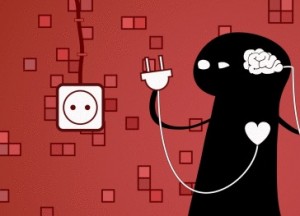The Executive System: Cognitive Science and Kabbalah (Part 2)
By Asher Crispe: September 4, 2012: Category Inspirations, Quilt of Translations
Control Centers of the Brain
 What’s going on upstairs? Seriously, ever want to pop the hood and figure out how this familiar stranger known as the human brain really works? Every since I was capable of bumping my head, I wanted to know what was so important about this sensitive spot. Does it come with reins or handles? Can we train it? Is it fixed? What’s flying?
What’s going on upstairs? Seriously, ever want to pop the hood and figure out how this familiar stranger known as the human brain really works? Every since I was capable of bumping my head, I wanted to know what was so important about this sensitive spot. Does it come with reins or handles? Can we train it? Is it fixed? What’s flying?
Let’s summon the mapmakers. These are the cognitive scientists of today armed with unprecedented tools for modeling the human brain. Neuroimaging counts on tools with acronyms such as PET, CAT, MRI, FMRI and a host of others probing our mental machinery. By employing both structural and functional imaging, scientists are getting an in depth look at what was once an incomprehensible black box. Mind reading is no longer a circus trick or psychic friends hotline call. There is still a long road ahead, but the race is on to reverse engineer the human brain.
When is comes to understanding how our brain function is distributed, there are several models to consider. For our present discussion we are going to continue to look for kabbalistic precedence for bicameralism and how it plays into the question of executive function. It is important to remember that this is not the only model to consider both from a neuroscience perspective and from the standpoint of Kabbalah. It’s baby steps. But then baby steps can be the most challenging of all.
In our previous article on the Executive System, we related how the two days of Rosh Hashanah (the Jewish New Year which literally means the ‘head of the year’) represent the right and left chambers of the mind. Additionally we proposed that all of the observances and events recorded and associated with Rosh Hashanah dramatize key ideas in cognitive science in general and the executive system in particular.
Many may not realize it but Rosh Hashanah is a famous birthday. Most would guess that is the birthday of the world or the first day of Creation in Genesis but they would hear the buzzer signaling their failure to take home the game show prize. Jewish tradition actually places the birthday of the world on the 25th of the Hebrew month of Elul which means that there is a week following that until Rosh Hashanah. The two days of Rosh Hashanah correspond to the sixth day of Creation and the first Sabbath on the Seventh day.
What is the significance of the Rosh Hashanah beginning with the sixth day?
The Torah records a significant facet of Creation on each of the week days. Day six is the creation of humanity. It’s the birthday of Adam (Adom) and Eve (Chava). More significantly, the entire drama of the six day–the encounter with the primordial snake and the eating from the Tree of Knowledge of Good and Evil–occurred during the first 24 hours of this Rosh Hashanah holiday. As a result, each and every Rosh Hashanah this meta-narrative is relived. In fact, it serves as a model for understanding one of the most basic basic problems in cognitive psychology–the loss or diminishing of executive function.
The dramatis personae of our story are the first man, the first woman and the first snake of Creation. The manner of ‘firstness’ may signify many things including, but not limited to, the beginning of a temporal order. In Kabbalah, these ‘firsts’ also mark a phenomenological primacy within the human consciousness. As the chassidic masters have long maintained, a person has not begun to comprehend the Torah until one realizes that everything that it is speaking about in all of its details is the story of one’s own autobiography as it unfolds in real time. This demands the greatest immersion into, and inflection of, the details of the Torah’s narrative. I become Adam and Eve and the Snake. I am the garden and the two trees. These are primordial places and occasions of the self that admit no spatial distance nor temporal interval separating them from myself.
So my primal sense of self which registers the novelty of being (Creation has always just happened–the surprise never wears off) is populated by three star actors. According to the Zohar, this cast was selected to represent the three seats of power–the three foci of control-flow–within the fabric of my inner experience. Their normative hierarchical order begins with cognition in the brain (moach מח) followed the emotive nest in the heart (lev לב) and concluding in the operative or behavioral functioning of the liver (kaved כבד). For those unaccustomed to thinking of the liver (kaved) in this capacity (even symbolically), you could connect it to the more commonly used expression of ‘going with your gut’ or ‘gut instinct.’
Playing the part of the mind is Adom (Adam). His wife Chava (Eve) is cast as the heart. Suddenly, another ‘first’ makes sense. This is our ‘first marriage’ in the Torah. The most basic union needed to be a complete person is the marriage of one’s head and heart. Adom (Adam) not marrying Chava (Eve) produces the very ‘first’ pathology of the soul. Under such unfortunate conditions, we lack inner integration. Domestic tranquility is the state of thought and emotion dwelling together in peace. Domestic disturbances are therefore, first and foremost, mental disturbances. My mind wants one thing and my heart desires another. Head and heart cannot get along.
So why the snake?
We are not all mind and heart. Often we operate on autopilot. We simply ‘function.’ I do, but I cannot tell you why I do or what I do. My behavior marches on, obeying instructions which I have no feeling for nor do I understand. The lowly solder within me has no clue what the commanding officer had in mind when he sent me off on a campaign. Orders were given but the reasons for them are on a need-to-know basis and the baseline accomplishment of those tasks does not require me to know. Much of the time I put one foot in front of the other, breathe, eat, digest and sleep without giving it much thought. My habits can anesthetize the emotions. Thus, the arch-nemesis for the mind (Adom) and heart (Chava) is always the gut behavioral instincts or liver (snake).
Not only does the routine tend to dull our wits and senses and stymie the growth of feelings, but it creates cognitive and emotive ambivalence and ambiguity. The venom of the snake acts as a paralytic. We find an allusion in the word nachash which means ‘snake’ but also relates to the word nichash which denotes ‘guessing’ or more abstractly a state of uncertainly or indeterminacy. Fumbling in the shadow of the unknown, my mind and heart are immobilized.
 The proper control-flow, established with the installation of these psychic elements as they are born anew (every time we experience the neuroplasticity of changing our state of consciousness on the ‘head of change’ [Rosh Hashanah]), was Adom (Adom) relaying a command message to Chava (Eve) who then related it to the Nachash (Snake). Thus, the executive order within each of us was originally intended to be one of the ‘moach shalet al ha’lev’ or the ‘mind ruling over the heart’ as is stated in the classic work of Chabad Chassidic Philosophy known as the Tanya. Moreover, the heart should rule over the liver.
The proper control-flow, established with the installation of these psychic elements as they are born anew (every time we experience the neuroplasticity of changing our state of consciousness on the ‘head of change’ [Rosh Hashanah]), was Adom (Adom) relaying a command message to Chava (Eve) who then related it to the Nachash (Snake). Thus, the executive order within each of us was originally intended to be one of the ‘moach shalet al ha’lev’ or the ‘mind ruling over the heart’ as is stated in the classic work of Chabad Chassidic Philosophy known as the Tanya. Moreover, the heart should rule over the liver.
In our alternative terminology, the rational mind (generally) takes precedence over the emotions in order to keep them in check. The emotions, if they receive instructions from the mind, should be able to rule over our gut instincts and govern changes in behavior. If this rectified order is expressed, then we have the formula wherein mind or moach (מח) over heart or lev (לב) over liver or kaved (כבד). When arranged in this fashion the acronym formed from these three Hebrew words spells Melech or King (מלך). To exercise full sovereignty over one’s inner domain, to possess self-mastery, one has to alight the control centers of the soul in this order.
In Part 3 we will explore the reversal of control that happened in the Edenic setting along with additional executive relationships in the soul.
The Executive System: Cognitive Science and Kabbalah (Part 2),






















;)
;)
;)
;)
;)
;)
;)
;)
;)
;)
